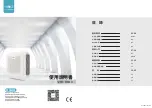
23
1.800.627.4499
HE-Series Indoor
ERV
OPERATION
It is important to balance the airflows after the unit is operational and all ductwork has been
installed. Balancing the airflows is typically required by state and/or local codes, and is often
specified by the HVAC design engineer.
Optimum efficiency of the enthalpic cores is achieved when the airstreams are properly balanced.
6.4 BALANCING AIRFLOWS
6.3 UNIT STARTUP
6.3.1 Fixed-Speed Units
Most fixed-speed units do not have any external controlling signals and only require turning
on the disconnect switch, located on the E-Box. When the disconnect switch is turned ON, any
dampers will first move into their correct operating positions and then power is suppled to the
motor contactors, causing the fans to run.
Some fixed-speed units are wired to receive an actuating signal from an external source.
If there is an external actuating signal source, verify the type of signal and that it is wired
according to the low-voltage wiring diagrams found in Section 5.6 of this manual. Turn on the
disconnect switch and then turn ON the actuating device. After any dampers have moved into
their correct positions, power is then applied to the motor contactors and the fans will begin
running.
During the construction and installation phases of a project, dust, dirt and debris will often
accumulate inside a unit. Thoroughly clean the inside of the unit by vacuuming and/or wiping metal
surfaces with a damp rag.
All HVAC installations are governed by local and state building codes, some of which include
specific requirements for balancing of airflows. In addition, the HVAC design engineer typically
includes a specification for balancing of airflows. If there is a conflict between the specification
sources, consult the HVAC design engineer.
A frequent requirement is for the airstreams to be perfectly balanced between Fresh Air supply
and Exhaust Air discharge. In practice, it is generally preferable to leave a slight imbalance
in the airflows, with the Exhaust Air set for slightly less than Fresh Air intake, producing a
slight positive pressure within the Occupied Space. The reason for doing this is to reduce
air infiltration, which is untempered air. Having an imbalance in the airstreams results in
slightly lower efficiency in the energy transfer in the enthalpic cores, but it is made up for by
the reduction in air infiltration.
Whenever airstreams are adjusted for an imbalance, the
imbalance should be no more than 5%
.
Each job site is different and equipment requirements
will vary. Example: there may be a water heater that is not ducted to the outside and therefore
consumes and discharges large amounts of building air.
The process of balancing airflows is accomplished after all ductwork has been installed and
examined for compliance to SMACNA guidelines. Improperly designed and installed ductwork
will cause turbulence in the airstreams and restrictions in airflow, all of which will lower the
operating efficiency of the HVAC system.
All airflow adjustments are dependent on taking accurate measurements of actual airflow by
means of a manometer in the test ports on the unit. For some units, digital controls may have
been installed that incorporate airflow sensors and it will not be necessary to take manometer
readings. For further information on using the information from an integrated commercial
controller, see the manual provided with the controller.
NOTE: ERV airflows
are to be balanced
after all ductwork is
installed. Balanc-
ing of airflows is typically
required by local or state
building codes or by the
HVAC design engineer.
IMPORTANT










































